Key takeaways:
- Selective mutism is an anxiety disorder that causes children to be silent in specific social situations, requiring understanding and empathy from adults.
- Parental support is crucial; creating safe environments and validating children’s feelings can significantly encourage them to communicate.
- Recognizing signs, like varying communication styles in different settings, is essential for early intervention and support for children with selective mutism.
- Engaging children through play and modeling social interactions can promote comfort and encourage them to participate in conversations.
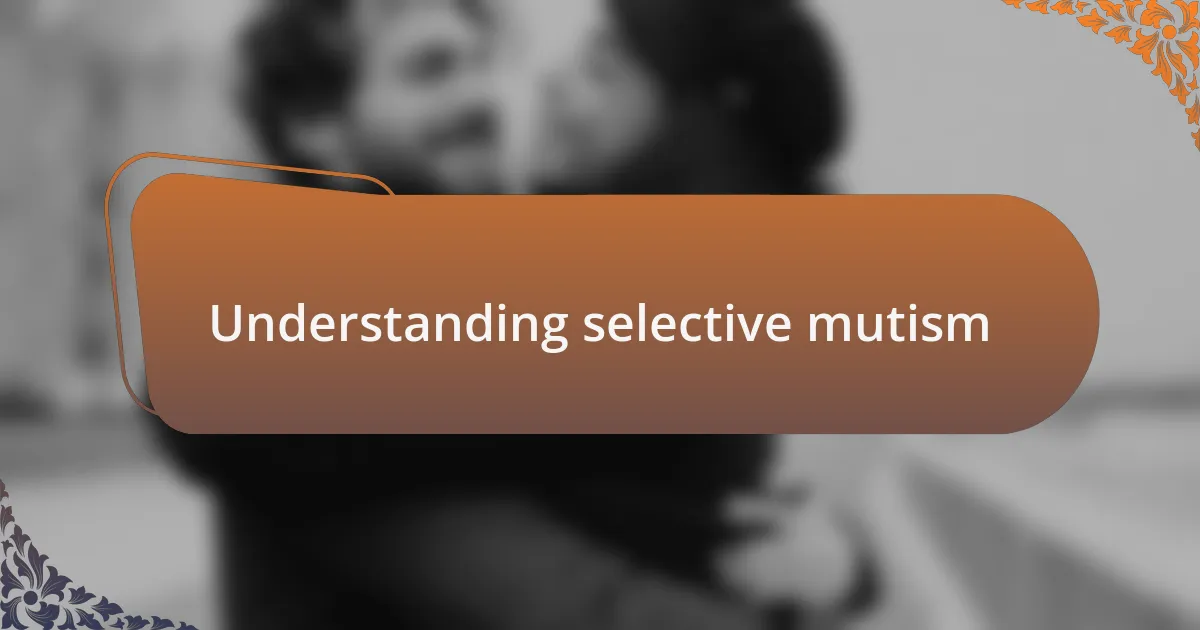
Understanding selective mutism
Selective mutism is a complex anxiety disorder that primarily affects children, causing them to be unable to speak in certain social situations where they feel pressured or uncomfortable. I remember a time when I witnessed a shy child, usually vibrant at home, retreat into silence during a classroom activity. It made me ponder—what unseen struggles are they facing in environments that seem so ordinary to others?
Often, this disorder can stem from a combination of environmental factors and temperament. I’ve seen how the pressure to speak can create overwhelming anxiety. What if the fear of judgment or the desire to fit in becomes so intense that it silences a voice that could otherwise shine? Understanding this inner experience is crucial for nurturing empathy and support.
It’s essential to recognize that selective mutism isn’t simply stubbornness or a phase; it’s legitimate distress. A friend of mine shared that her child would respond verbally only to close family members, which felt like a heartbreaking barrier for her. Could you ever imagine feeling trapped by your own silence? It’s a reminder that patience and understanding can be powerful tools in helping children navigate their unique journeys.
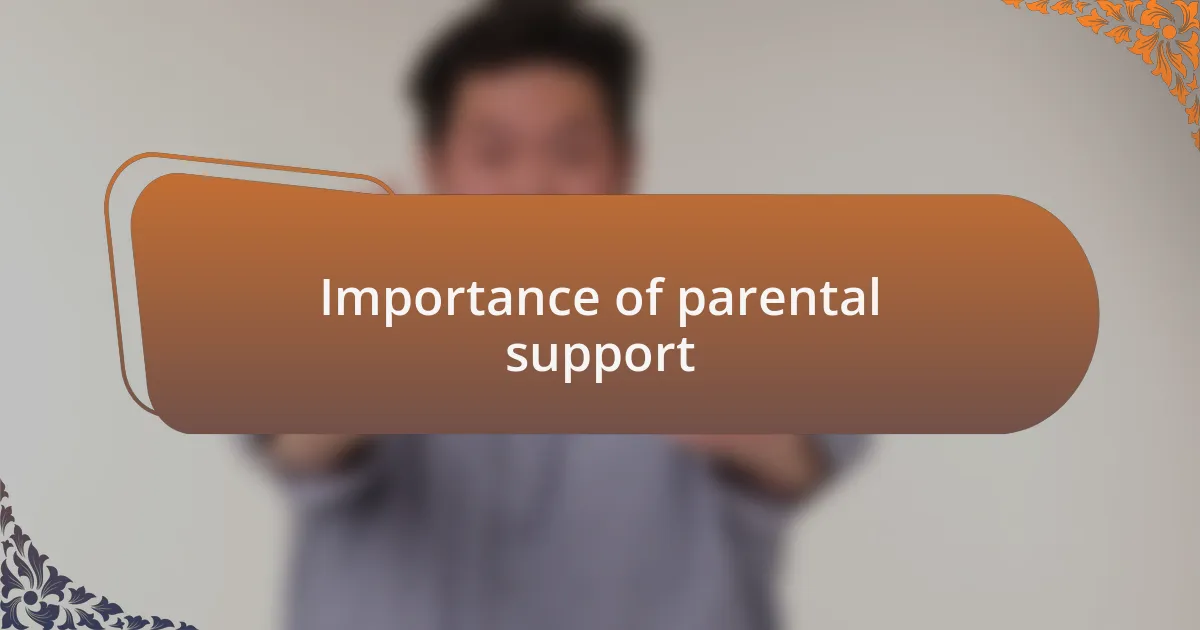
Importance of parental support
Parental support plays a vital role in helping children with selective mutism break free from the chains of their silence. I recall a conversation I had with a mother who took the time to understand her child’s triggers. By creating a safe environment at home, she noticed her daughter began to express herself more freely, particularly when they practiced speaking together during family game nights. Isn’t it fascinating how the right support can create a bridge for communication?
When parents acknowledge and validate their child’s feelings, they empower them to take small steps toward overcoming their fears. A friend of mine shared how her son felt seen and heard when she praised his tiny attempts to speak outside their comfort zone. This sense of achievement can significantly boost a child’s confidence. Have you ever felt that surge of encouragement when someone notices your efforts? It can be transformative.
Moreover, involved parents can connect with teachers and therapists, forming a team that works towards a common goal. I’ve seen firsthand how collaboration can enhance a child’s comfort levels in school settings. Imagine the impact of a supportive network, where everyone is tuned in to the child’s needs, fostering an atmosphere of resilience and hope. Isn’t it inspiring to think about the potential of united efforts in making a meaningful difference?
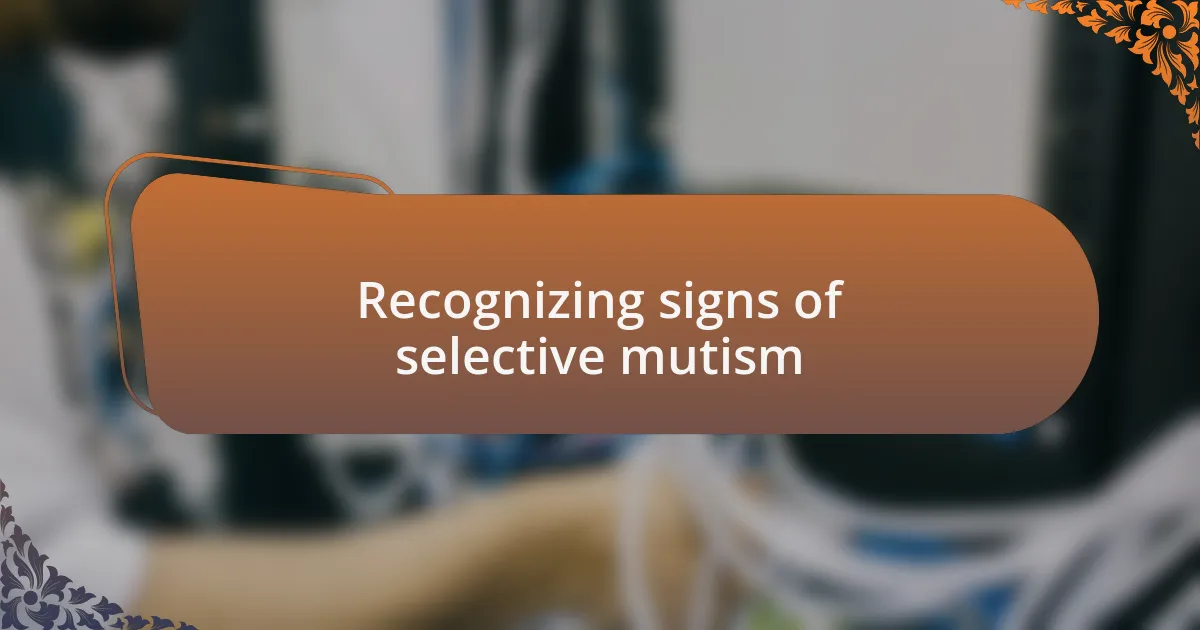
Recognizing signs of selective mutism
Recognizing selective mutism can start with observing a child’s comfort in various social settings. For instance, I remember a family gathering where a quiet little girl stood silently on the sidelines while other children played. When I chatted with her mother, she pointed out that at home, her daughter was expressive, but outside, she struggled to find her voice. Have you ever noticed a child being vibrant in private but reserved in public? That contrast can be a key indicator.
Another sign to look for is the level of anxiety that arises in social situations. I once encountered a boy who, when asked to speak in front of his peers, would look down and fidget nervously. It became clear that his discomfort was linked to selective mutism rather than shyness alone. Observing these physical cues can provide insight and lead to understanding how deep the issue runs. Isn’t it eye-opening how those simple gestures can tell us so much about a child’s internal struggle?
Additionally, if a child communicates differently in safe environments, it’s worth investigating further. I know of a young girl who would only whisper her thoughts to her family but would completely shut down in school. This pattern was crucial for her parents to recognize. It makes you wonder: how often do we overlook these signals? Catching these signs early is essential, as it can pave the way for seeking the right support and fostering healthier communication.
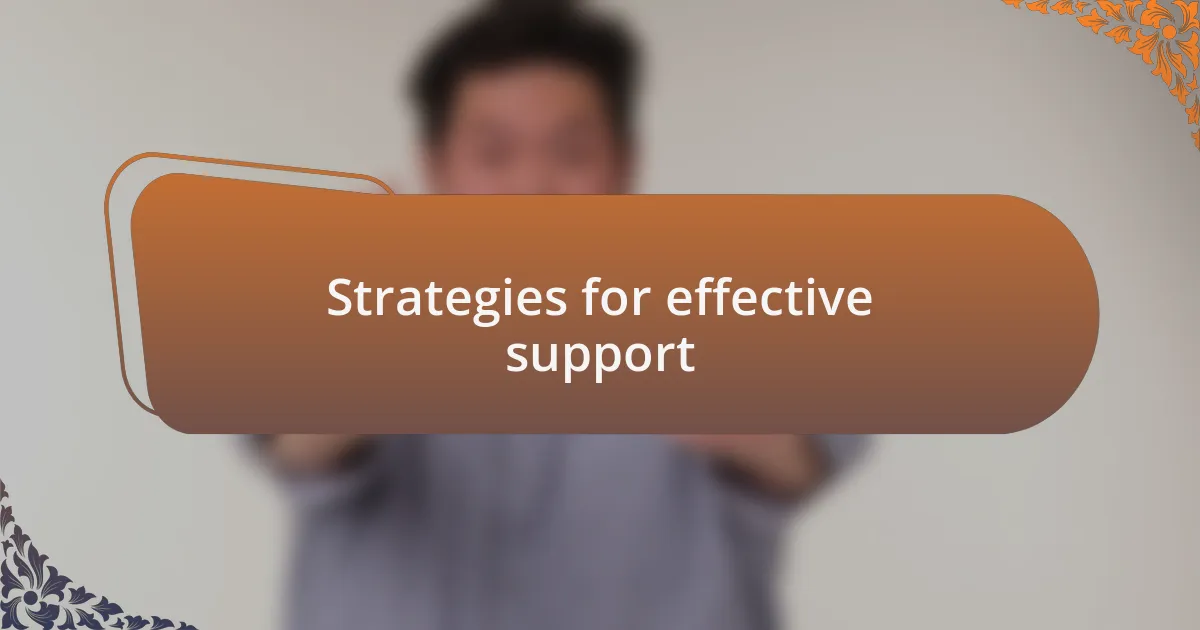
Strategies for effective support
When it comes to supporting a child with selective mutism, creating a safe and encouraging environment is paramount. I recall a time when a friend set up a special ‘talking corner’ at home, filled with engaging books and soft toys, where her daughter could express herself freely. This playful approach not only made communication less intimidating but also fostered a sense of security—an essential element for children grappling with their voice. Isn’t it amazing how a simple change in surroundings can transform a child’s willingness to communicate?
Another effective strategy involves using gradual exposure to social situations. I once witnessed a parent invite a few trusted friends over for a playdate, allowing her child to engage at their own pace. Initially, the child chose to observe, but gradually, she began to participate in small ways, like nodding or pointing. It was inspiring to see the confidence grow without pressure. Have you thought about how small interactions can build up a child’s comfort over time?
Finally, collaboration with educators can make a huge difference. I remember joining a parent-teacher meeting where a supportive teacher accepted the challenge of tailoring participation methods for a student with selective mutism. By implementing non-verbal cues and pairing them with a buddy system, the child felt more included without the fear of speaking up. Isn’t it rewarding when schools actively support our children’s needs? Engaging with educators ensures a consistent approach, making the child feel understood both at home and in school.
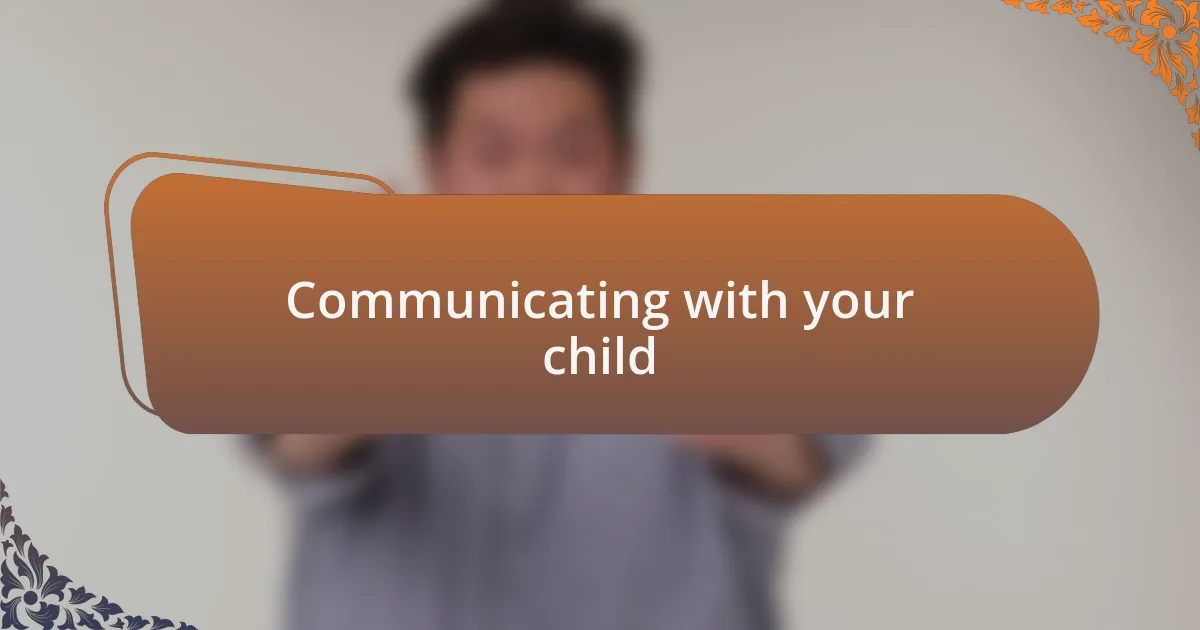
Communicating with your child
When I think about communicating with a child who has selective mutism, I remember how my niece would sometimes express herself through drawings instead of words. One day, she handed me a crayon-drawn family portrait, and in that moment, I realized that understanding her feelings was more important than expecting spoken words. Isn’t it remarkable how children often find unique ways to convey their thoughts and emotions?
I’ve also learned the power of patience in these situations. During a quiet afternoon, I sat with my neighbor’s son while he flipped through a storybook without uttering a single word. Instead of filling the silence with chatter, I simply asked open-ended questions about the pictures, allowing him to respond in his own way—whether through gestures or brief smiles. Have you ever noticed how giving a child space can lead to authentic connection, even if it doesn’t involve spoken language?
Finally, I can’t stress enough the importance of tone during these interactions. I once attended a workshop where the facilitator encouraged us to speak with a gentle, inviting tone, which instantly changed the atmosphere. It allowed children to feel safe enough to share their thoughts, even if it was just a whisper. Can you see how the right approach can create a bridge for communication? Children often mirror the emotions we convey, so fostering a nurturing tone can open those doors to dialogue.
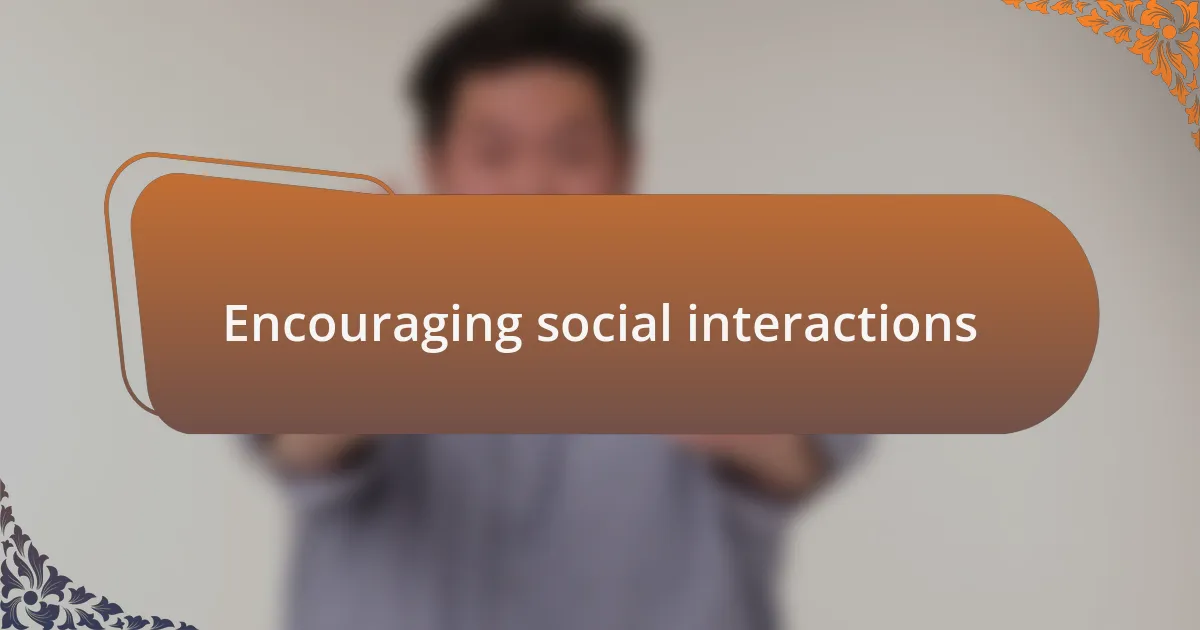
Encouraging social interactions
When it comes to encouraging social interactions, I’ve found that creating small, manageable settings can make a big difference. I remember hosting a playdate for my friends with children who struggled with speech. Instead of large groups, we invited just a few kids, allowing everyone to feel comfortable and less pressured to speak. Have you ever noticed how a familiar environment can loosen the tension and bring out the best in kids?
Another approach I’ve taken is using playful activities that indirectly promote interaction. For example, I once organized a puppet-making session. The children were so engaged in crafting their puppets that communication flowed naturally as they began to act out little skits together, often laughing and sharing ideas without any pressure to speak. It’s fascinating how play can create a safe space for expression, don’t you think?
Lastly, I encourage parents to model social interactions through their own behavior. One day, while at the park, I watched a mother approach another parent to discuss their children’s interests. It struck me how her openness created a welcoming atmosphere. If kids can observe us practicing social skills, it empowers them to replicate those behaviors in their own interactions. Can you imagine the impact of simply demonstrating friendly conversations for our kids?

Sharing personal experiences
Sharing personal experiences can be incredibly powerful, especially when tackling something like selective mutism. I remember a moment when my child finally opened up to a trusted family member during a quiet afternoon at home. The laughter that erupted as they played their favorite board game was a revelation, underscoring the importance of familiar faces in reducing anxiety. Have you ever witnessed a breakthrough like that? It’s as if the barriers seem to dissolve in a safe space.
Another vivid memory comes to mind from a school event. I sat with other parents, sharing stories of our children’s challenges and victories. One mother described her daughter’s struggle with speaking up in class, and I felt an instant connection. It was eye-opening to realize that we weren’t alone in this journey; our shared experiences created a sense of community that was truly uplifting. How often do we overlook the value of simply talking to someone who understands?
One day, I decided to keep a journal to reflect on my experiences with my child’s selective mutism. Writing about our challenges and triumphs became not only therapeutic for me but also a resource I could share with other parents. Looking back at those entries, I can see how much progress we’ve made and the role support has played in that journey. Isn’t it amazing how sharing our stories can foster empathy and understanding in ways we never anticipated?